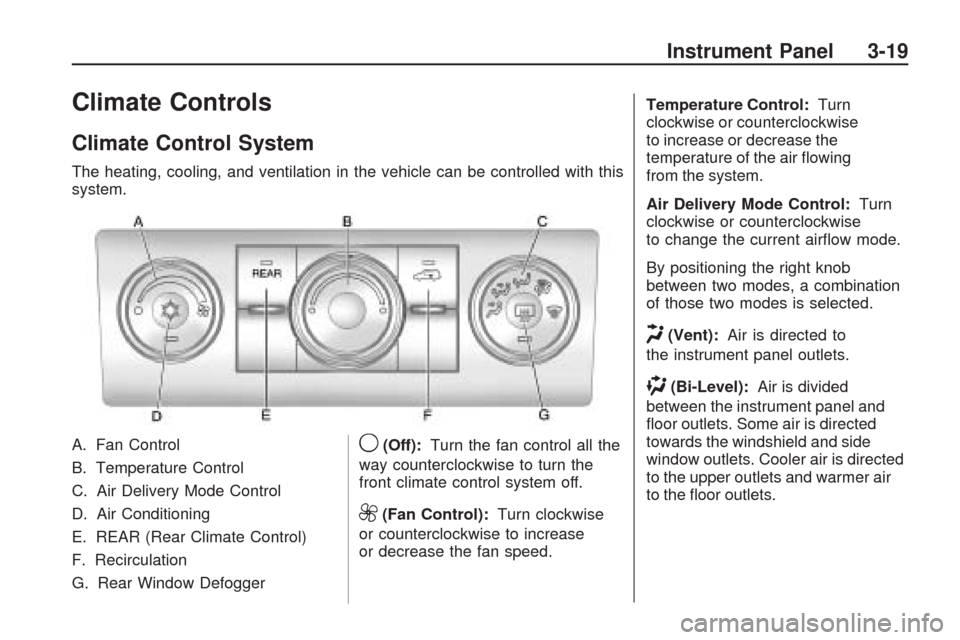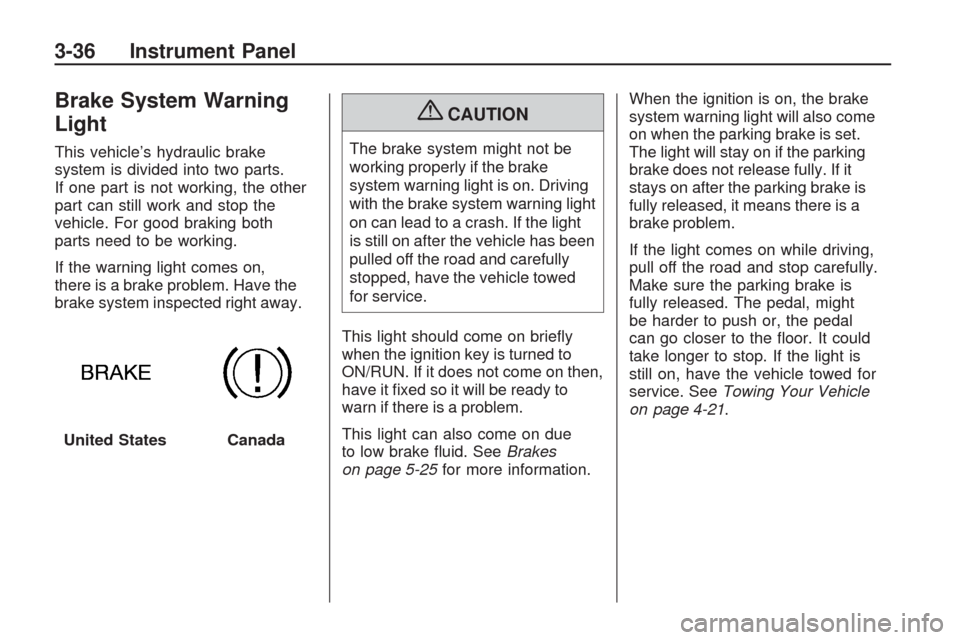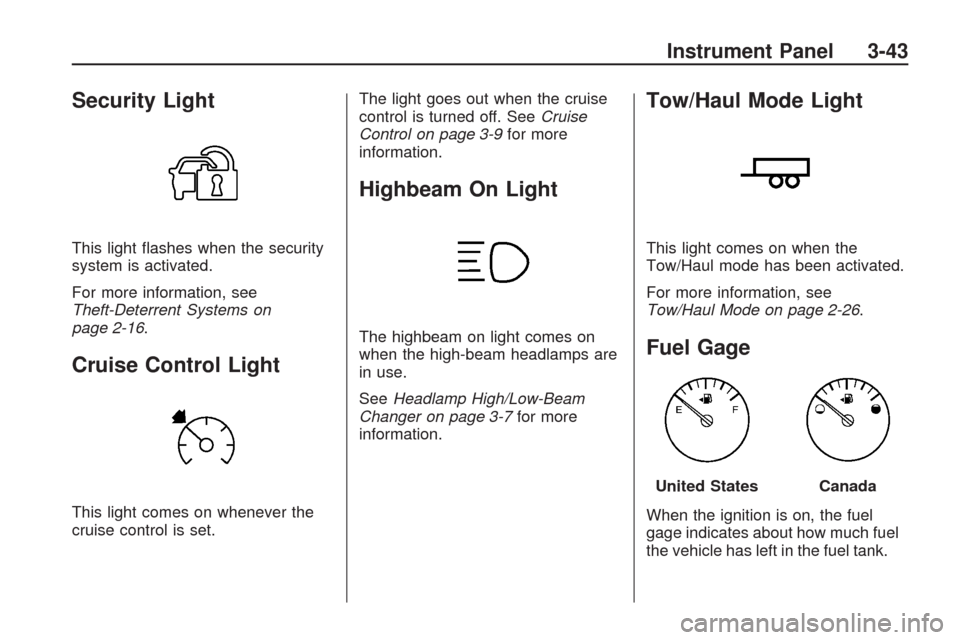2009 CHEVROLET TRAVERSE tow
[x] Cancel search: towPage 125 of 422

The main components of the
instrument panel are listed here:
A.Turn Signal/Multifunction
Lever on page 3-6.Windshield
Wipers on page 3-7.
B.Instrument Panel Cluster on
page 3-31.
C.Audio Steering Wheel Controls
on page 3-125.
D.Instrument Panel Storage on
page 2-52.
E.Audio System(s) on page 3-73
orNavigation/Radio System on
page 3-103(If Equipped).
F.Outlet Adjustment on page 3-27.
G.Exterior Lamps on page 3-11.
Fog Lamps on page 3-13
(If Equipped).
H.Dome Lamp Override on
page 3-14.Instrument Panel
Brightness on page 3-13. Heated
Windshield Washer Button. See
Windshield Washer on page 3-8.
I.Cruise Control on page 3-9.
J.Tilt and Telescopic Steering
Wheel on page 3-6.K.Horn on page 3-5.
L.Driver Information Center (DIC)
on page 3-44.
M.Climate Control System on
page 3-19orDual Automatic
Climate Control System on
page 3-22.
N. Shift Lever. SeeShifting Into
Park on page 2-28.
O.Accessory Power Outlet(s) on
page 3-17.
P.Rear Window Wiper/Washer
on page 3-9. Traction Control
System (TCS) Disable Button.
SeeStabiliTrak
®System on
page 4-5.Tow/Haul Mode
on page 2-26(If Equipped).
Power Liftgate on page 2-11
(If Equipped).
Q.Heated Seats on page 1-5.
R.Hazard Warning Flashers on
page 3-5.
S. Passenger Air Bag Status
Indicator.
T.Glove Box on page 2-52.
Hazard Warning Flashers
|
Hazard Warning Flasher:Press
this button located on the instrument
panel below the audio system, to
make the front and rear turn signal
lamps �ash on and off. This warns
others that you are having trouble.
Press again to turn the �ashers off.
The turn signals do not work while
the hazard warning �ashers are on.
Horn
Press near or on the horn symbols
on the steering wheel pad to sound
the horn.
Instrument Panel 3-5
Page 127 of 422

Turn Signal On Chime
If either one of the turn signals are
left on and the vehicle has been
driven more than 3/4 mile (1.2 km),
a chime will sound.
Headlamp High/
Low-Beam Changer
23
Headlamp High/Low Beam
Changer:Push the turn signal/
multifunction lever away from you
to turn the high beams on.
Pull the lever towards you to return to
low beams.
This indicator light turns on in the
instrument panel cluster when the
high beam headlamps are on.
Flash-to-Pass
This feature is used to signal to the
vehicle ahead that you want to pass.
If the headlamps are off or in
the low-beam position, pull the
turn signal lever toward you to
momentarily switch to high-beams.
Release the lever to turn the
high-beam headlamps off.
Windshield Wipers
The windshield wiper/washer
lever is located on the right side
of the steering column.
Turn the band with the wiper symbol
to control the windshield wipers.
8(Mist):Turn the band to mist
for a single wiping cycle and then
release. The wipers stop after one
wipe. Hold the band on
8longer,
for more wipe cycles.
9(Off):Turns the wipers off.
6(Delay):Adjusts the delay time.
The delay between wiping cycles
becomes shorter as the band
is moved to the top of the lever.
1 (Low Speed):For steady wiping
at low speed.
2 (High Speed):For steady wiping
at high speed.
Clear ice and snow from the wiper
blades before using them. If the
blades are frozen to the windshield,
gently loosen or thaw them. If they
become damaged, install new blades
or blade inserts. SeeWindshield
Wiper Blade Replacement on
page 5-35.
Heavy snow or ice can overload the
wipers. A circuit breaker stops them
until the motor cools.
Instrument Panel 3-7
Page 139 of 422

Climate Controls
Climate Control System
The heating, cooling, and ventilation in the vehicle can be controlled with this
system.
A. Fan Control
B. Temperature Control
C. Air Delivery Mode Control
D. Air Conditioning
E. REAR (Rear Climate Control)
F. Recirculation
G. Rear Window Defogger
9(Off):Turn the fan control all the
way counterclockwise to turn the
front climate control system off.
9(Fan Control): Turn clockwise
or counterclockwise to increase
or decrease the fan speed. Temperature Control:
Turn
clockwise or counterclockwise
to increase or decrease the
temperature of the air �owing
from the system.
Air Delivery Mode Control: Turn
clockwise or counterclockwise
to change the current air�ow mode.
By positioning the right knob
between two modes, a combination
of those two modes is selected.
H(Vent): Air is directed to
the instrument panel outlets.
)(Bi-Level): Air is divided
between the instrument panel and
�oor outlets. Some air is directed
towards the windshield and side
window outlets. Cooler air is directed
to the upper outlets and warmer air
to the �oor outlets.
Instrument Panel 3-19
Page 144 of 422

PASS (Passenger):Press to
set the passenger temperature to
match the driver temperature setting.
The PASS indicator will turn off.
When the passenger temperature
setting is different than the driver
setting, the PASS indicator
comes on.
Manual Operation
The air delivery mode or fan speed
can be manually adjusted.
D/C(Fan Control):Press to
increase or decrease the fan speed.
Pressing
DorCwhile in automatic
control places the fan speed
under manual control.The air delivery mode remains in
automatic control. The fan setting
still displays, but the word AUTO
no longer displays, and the AUTO
button indicator light turns off.
H/G(Air Delivery Mode Control):
Press to change the direction of the
air�ow in the vehicle. Repeatedly
press
HorGuntil the desired mode
appears on the display. Pressing a
mode button while the system is
off changes the air delivery mode
without turning the system on. Press
a mode button while in automatic
control to place the system into
manual control.
The air delivery mode setting still
displays, but the word AUTO no
longer displays, and the AUTO
button indicator light turns off.
H(Vent):Air is directed to the
instrument panel outlets.
)(Bi-Level):Air is divided
between the instrument panel and
�oor outlets. Some air is directed
towards the windshield and side
window outlets. Cooler air is directed
to the upper outlets and warmer air
to the �oor outlets.
6(Floor):Air is directed to the
�oor outlets, with some of the air
directed to the windshield, side
window, and second row �oor
outlets. In this mode, the system
uses outside air.
3-24 Instrument Panel
Page 156 of 422

Brake System Warning
Light
This vehicle’s hydraulic brake
system is divided into two parts.
If one part is not working, the other
part can still work and stop the
vehicle. For good braking both
parts need to be working.
If the warning light comes on,
there is a brake problem. Have the
brake system inspected right away.
{CAUTION
The brake system might not be
working properly if the brake
system warning light is on. Driving
with the brake system warning light
on can lead to a crash. If the light
is still on after the vehicle has been
pulled off the road and carefully
stopped, have the vehicle towed
for service.
This light should come on brie�y
when the ignition key is turned to
ON/RUN. If it does not come on then,
have it �xed so it will be ready to
warn if there is a problem.
This light can also come on due
to low brake �uid. SeeBrakes
on page 5-25for more information.When the ignition is on, the brake
system warning light will also come
on when the parking brake is set.
The light will stay on if the parking
brake does not release fully. If it
stays on after the parking brake is
fully released, it means there is a
brake problem.
If the light comes on while driving,
pull off the road and stop carefully.
Make sure the parking brake is
fully released. The pedal, might
be harder to push or, the pedal
can go closer to the �oor. It could
take longer to stop. If the light is
still on, have the vehicle towed for
service. SeeTowing Your Vehicle
on page 4-21.
United States
Canada
3-36 Instrument Panel
Page 160 of 422

If the check engine light comes on
and stays on, while the engine
is running, this indicates that there
is an OBD II problem and service
is required.
Malfunctions often are indicated by
the system before any problem is
apparent. Being aware of the light
can prevent more serious damage
to the vehicle. This system assists
the service technician in correctly
diagnosing any malfunction.
Notice:If the vehicle is
continually driven with this
light on, after a while, the
emission controls might not
work as well, the vehicle’s fuel
economy might not be as good,
and the engine might not run as
smoothly. This could lead to
costly repairs that might not be
covered by the vehicle warranty.Notice:Modi�cations made to
the engine, transmission, exhaust,
intake, or fuel system of the
vehicle or the replacement of the
original tires with other than those
of the same Tire Performance
Criteria (TPC) can affect the
vehicle’s emission controls and
can cause this light to come on.
Modi�cations to these systems
could lead to costly repairs not
covered by the vehicle warranty.
This could also result in a failure
to pass a required Emission
Inspection/Maintenance test.
SeeAccessories and
Modifications on page 5-3.This light comes on during a
malfunction in one of two ways:
Light Flashing:A mis�re condition
has been detected. A mis�re
increases vehicle emissions and
could damage the emission control
system on the vehicle. Diagnosis
and service might be required.
The following can prevent more
serious damage to the vehicle:
Reduce vehicle speed.
Avoid hard accelerations.
Avoid steep uphill grades.
If towing a trailer, reduce the
amount of cargo being hauled
as soon as it is possible.
If the light continues to �ash, when
it is safe to do so, stop the vehicle.
Find a safe place to park the vehicle.
Turn the key off, wait at least
10 seconds, and restart the engine.
If the light is still �ashing, follow the
previous steps and see your dealer/
retailer for service as soon as
possible.
3-40 Instrument Panel
Page 163 of 422

Security Light
This light �ashes when the security
system is activated.
For more information, see
Theft-Deterrent Systems on
page 2-16.
Cruise Control Light
This light comes on whenever the
cruise control is set.The light goes out when the cruise
control is turned off. SeeCruise
Control on page 3-9for more
information.
Highbeam On Light
The highbeam on light comes on
when the high-beam headlamps are
in use.
SeeHeadlamp High/Low-Beam
Changer on page 3-7for more
information.
Tow/Haul Mode Light
This light comes on when the
Tow/Haul mode has been activated.
For more information, see
Tow/Haul Mode on page 2-26.
Fuel Gage
When the ignition is on, the fuel
gage indicates about how much fuel
the vehicle has left in the fuel tank.
United StatesCanada
Instrument Panel 3-43
Page 242 of 422

ProblemRecommended Action
Sometimes the wireless headphone
audio cuts out or buzzes. Check for obstructions, low
batteries, reception range,
and interference from cellular
telephone towers or by using a
cellular telephone in the vehicle.
Check that the headphones are
on correctly using the L (left) and
R (right) on the headphones.
I lost the remote and/or the
headphones. See your dealer/retailer for
assistance.
The DVD is playing, but there is no
picture or sound. Check that the RSE video screen is
sourced to the DVD player.
DVD Display Error Messages
The DVD display error message
depends on which radio the vehicle
has. The video screen might
display one of the following:
Disc Load/Eject Error:
This
message displays when there are
disc load or eject problems.
Disc Format Error: This message
displays if the disc is inserted with
the disc label wrong side up, or if the
disc is damaged. Disc Region Error:
This message
displays if the disc is not from a
correct region.
No Disc Inserted: This message
displays if no disc is present
when the
ZEJECT button
is pressed on the radio.
DVD Distortion
Video distortion can occur when
operating cellular phones, scanners,
CB radios, Global Position Systems
(GPS)*, two-way radios, mobile fax,
or walkie talkies.
It might be necessary to turn off the
DVD player when operating one of
these devices in or near the vehicle.
*Excludes the OnStar
®System.
Cleaning the RSE Overhead
Console
When cleaning the RSE overhead
console surface, use only a clean
cloth dampened with clean water.
Cleaning the Video Screen
Use only a clean cloth dampened
with clean water. Use care when
directly touching or cleaning the
screen, as damage could result.
3-122 Instrument Panel